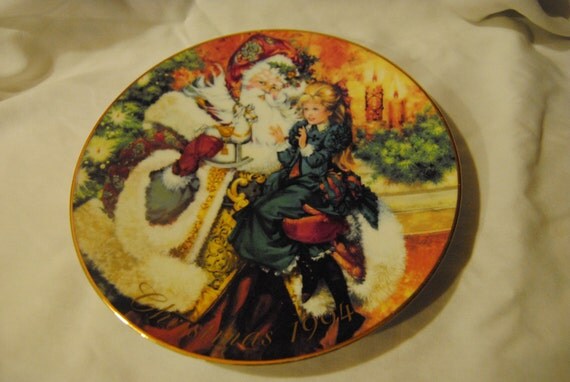RAINING and I do mean raining here today. They’re showing garbage cans floating down the street on Kaley at Orange in Orlando. Tornado Warnings earlier—none at the moment.
AND NOW FOR SOME SUNNY NEWS: I HAVE STARTED MY
STORE: DRAGONLAIRE https://www.etsy.com/shop/DragonLaire

DECORATIVE 1994 AVON CHRISTMAS Plate
Just one of the offerings and I will be adding more daily—please check it out.
The store on this site is active too….check that one as well…see listing above.
AND THERE’S ALWAYS HIM TO BRIGHTEN MY DAY:

CHECK OUT MY WHY I LOVE OUTLANDER ON http://www.pinterest.com/lindachase56829/why-i-love-outlander/
Today we’re looking a collectibles (a weekly feature since a collectible store pays for this blog)–candleholders and candelabras.
ELECTRICITY has been around for more than a century now, but that doesn’t mean candles and their holders, aren’t still popular.
With the discovery of fire, the earliest form of artificial lighting used to illuminate an area were campfires or torches. http://en.wikipedia.org/wiki/Lighting
Thousands of years before Christ shallow rock, shell, or other natural found object were filled with moss or a similar material that was soaked in animal fat and ignited. (PS I couldn’t find of these on sale on line sorry) http://en.wikipedia.org/wiki/Timeline_of_lighting_technology
7 Arms Solid Brass Candelabra 13 3/4″ Tall,


$119.00
As time passed, materials such as pottery and alabaster were used. Wicks were added to the lamp to control the rate of burning. http://www.ies.org/lighting/history/
Around the 7th century BC, the Greeks began making terra cotta lamps to replace handheld torches. The word lamp is derived from the Greek word lampas, meaning torch. http://inventors.about.com/od/lstartinventions/a/lighting.htm
monkey And Squirrel Metal Fireplace Candle Holder– Holds 8



$222.22
The Egyptians were using wicked candles in 3,000 B.C., but the ancient Romans are generally credited with developing the wicked candle before that time by dipping rolled papyrus repeatedly in melted tallow or beeswax. The resulting candles were used to light their homes, to aid travelers at night, and in religious ceremonies. http://candles.org/history/
During the Middle Ages candles became more prevalent in worship. It was at this time that beeswax was used to make candles. These beeswax candles were made much like the Romans made their candles with tallow. Beeswax was a drastic improvement from the tallow, but limited quantities were available, which made it expensive limiting it to clergy and the upper class. – See more at: https://www.candlewic.com/service/about-candlewic/candle-making-history/page.aspx?id=2216#sthash.gVnk8JEJ.dpuf
In England and France, Candle making had become a guild craft by the 13th century. These candle makers (chandlers) made candles from fats saved from the kitchen or sold their own candles from within their shops. http://en.wikipedia.org/wiki/History_of_candle_making
Early 1900 French Bronze Antique Candelabra

$520.00
The next innovation in the candle making industry came in the 18th century with the explosion of the whaling industry. It was discovered that “spermaceti,” a wax obtained by crystallizing sperm whale oil, would not only produce an odorless candle, but also burned significantly brighter, and created a harder candle that was much more resistant to heat. It was from this spermaceti wax that the first “standard candles” were produced.
Antique Pair Of 7 Light Candelabra Candlesticks


$580.00
Patented technology created by inventor Joseph Morgan allowed for the economical production of molded candles and brought candles to households everywhere. The spread of mechanical candle making paved the way for scented candles that reside in many homes today. http://www.overstock.com/guides/history-of-scented-candles
Today, we do not rely so much on candles for lighting our homes, except in the event of a power outage. Candles are now used for decorative or religious purposes, to create a mood with their hypnotic glow, their soothing fragrances please our sense of smell, and they often represent symbols of our personal faiths. http://www.generalwax.com/candle-making/about-candles.php

This pair of figural five-light candelabra after Clodion with satyr figures are bronze with a Carara marble base and sold at aution in Detroit in early 2013 for $3,900. (KOVELS)
“Look at how a single candle can both defy and define the darkness.”
― Anne Frank
― Anne Frank
